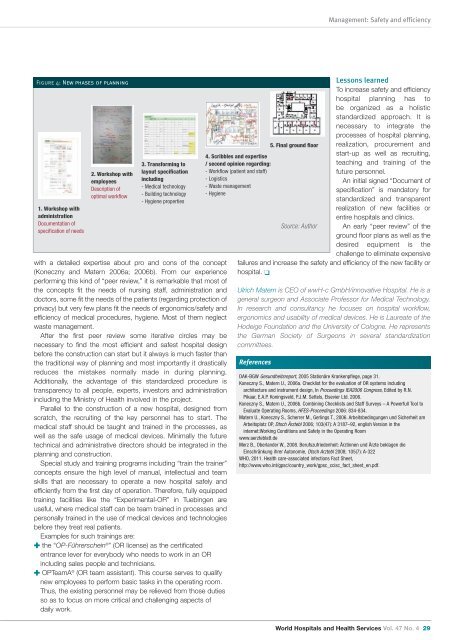web_vol47 4.pdf - International Hospital Federation
web_vol47 4.pdf - International Hospital Federation
web_vol47 4.pdf - International Hospital Federation
You also want an ePaper? Increase the reach of your titles
YUMPU automatically turns print PDFs into web optimized ePapers that Google loves.
Management: Safety and efficiency<br />
Figure 4: New phases of planning<br />
1. Workshop with<br />
administration<br />
Documentation of<br />
specification of needs<br />
2. Workshop with<br />
employees<br />
Description of<br />
optimal workflow<br />
3. Transforming to<br />
layout specification<br />
including<br />
- Medical technology<br />
- Building technology<br />
- Hygiene properties<br />
with a detailed expertise about pro and cons of the concept<br />
(Koneczny and Matern 2006a; 2006b). From our experience<br />
performing this kind of “peer review,” it is remarkable that most of<br />
the concepts fit the needs of nursing staff, administration and<br />
doctors, some fit the needs of the patients (regarding protection of<br />
privacy) but very few plans fit the needs of ergonomics/safety and<br />
efficiency of medical procedures, hygiene. Most of them neglect<br />
waste management.<br />
After the first peer review some iterative circles may be<br />
necessary to find the most efficient and safest hospital design<br />
before the construction can start but it always is much faster than<br />
the traditional way of planning and most importantly it drastically<br />
reduces the mistakes normally made in during planning.<br />
Additionally, the advantage of this standardized procedure is<br />
transparency to all people, experts, investors and administration<br />
including the Ministry of Health involved in the project.<br />
Parallel to the construction of a new hospital, designed from<br />
scratch, the recruiting of the key personnel has to start. The<br />
medical staff should be taught and trained in the processes, as<br />
well as the safe usage of medical devices. Minimally the future<br />
technical and administrative directors should be integrated in the<br />
planning and construction.<br />
Special study and training programs including “train the trainer”<br />
concepts ensure the high level of manual, intellectual and team<br />
skills that are necessary to operate a new hospital safely and<br />
efficiently from the first day of operation. Therefore, fully equipped<br />
training facilities like the “Experimental-OR” in Tuebingen are<br />
useful, where medical staff can be team trained in processes and<br />
personally trained in the use of medical devices and technologies<br />
before they treat real patients.<br />
Examples for such trainings are:<br />
✚ the “OP-Führerschein ® ” (OR license) as the certificated<br />
entrance lever for everybody who needs to work in an OR<br />
including sales people and technicians.<br />
✚ OPTeamA ® (OR team assistant). This course serves to qualify<br />
new employees to perform basic tasks in the operating room.<br />
Thus, the existing personnel may be relieved from those duties<br />
so as to focus on more critical and challenging aspects of<br />
daily work.<br />
4. Scribbles and expertise<br />
/ second opinion regarding:<br />
- Workflow (patient and staff)<br />
- Logistics<br />
- Waste management<br />
- Hygiene<br />
Lessons learned<br />
To increase safety and efficiency<br />
hospital planning has to<br />
be organized as a holistic<br />
standardized approach. It is<br />
necessary to integrate the<br />
processes of hospital planning,<br />
realization, procurement and<br />
start-up as well as recruiting,<br />
teaching and training of the<br />
future personnel.<br />
An initial signed “Document of<br />
specification” is mandatory for<br />
standardized and transparent<br />
realization of new facilities or<br />
entire hospitals and clinics.<br />
An early “peer review” of the<br />
ground floor plans as well as the<br />
desired equipment is the<br />
challenge to eliminate expensive<br />
failures and increase the safety and efficiency of the new facility or<br />
hospital. ❏<br />
Ulrich Matern is CEO of wwH-c GmbH/innovative <strong>Hospital</strong>. He is a<br />
general surgeon and Associate Professor for Medical Technology.<br />
In research and consultancy he focuses on hospital workflow,<br />
ergonomics and usability of medical devices. He is Laureate of the<br />
Hodeige Foundation and the University of Cologne. He represents<br />
the German Society of Surgeons in several standardization<br />
committees.<br />
References<br />
5. Final ground floor<br />
Source: Author<br />
DAK-BGW Gesundheitsreport, 2005 Stationäre Krankenpflege, page 31.<br />
Koneczny S., Matern U., 2006a. Checklist for the evaluation of OR systems including<br />
architecture and instrument design, In Proceedings IEA2006 Congress, Edited by R.N.<br />
Pikaar, E.A.P. Koningsveld, P.J.M. Settels, Elsevier Ltd. 2006.<br />
Koneczny S., Matern U., 2006b. Combining Checklists and Staff Surveys – A Powerfull Tool to<br />
Evaluate Operating Rooms, HFES-Proceedings 2006: 834-834.<br />
Matern U., Koneczny S., Scherrer M., Gerlings T., 2006. Arbeitsbedingungen und Sicherheit am<br />
Arbeitsplatz OP, Dtsch Ärztebl 2006; 103(47): A 3187–92, english Version in the<br />
internet:Working Conditions and Safety in the Operating Room<br />
www.aerzteblatt.de<br />
Merz B., Oberlander W., 2008. Berufszufriedenheit: Ärztinnen und Ärzte beklagen die<br />
Einschränkung ihrer Autonomie, Dtsch Arztebl 2008; 105(7): A-322<br />
WHO, 2011. Health care-associated infections Fact Sheet,<br />
http://www.who.int/gpsc/country_work/gpsc_ccisc_fact_sheet_en.pdf.<br />
World <strong>Hospital</strong>s and Health Services Vol. 47 No. 4 29
















